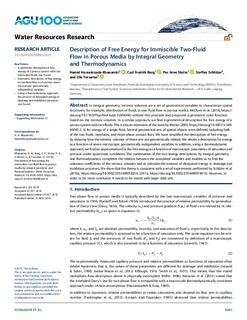| dc.contributor.author | Khanamiri, Hamid Hosseinzade | |
| dc.contributor.author | Berg, Carl Fredrik | |
| dc.contributor.author | Slotte, Per Arne | |
| dc.contributor.author | Schlüter, Steffen | |
| dc.contributor.author | Torsæter, Ole | |
| dc.date.accessioned | 2019-02-13T17:22:52Z | |
| dc.date.available | 2019-02-13T17:22:52Z | |
| dc.date.created | 2018-12-21T09:33:17Z | |
| dc.date.issued | 2018 | |
| dc.identifier.issn | 0043-1397 | |
| dc.identifier.uri | http://hdl.handle.net/11250/2585332 | |
| dc.description.abstract | In integral geometry, intrinsic volumes are a set of geometrical variables to characterize spatial structures, for example, distribution of fluids in two‐fluid flow in porous media. McClure et al. (2018, https://doi.org/10.1103/PhysRevFluids.3.084306) utilized this principle and proposed a geometric state function based on the intrinsic volumes. In a similar approach, we find a geometrical description for free energy of a porous system with two fluids. This is also an extension of the work by Mecke (2000, https://doi.org/10.1007/3-540-45043-2_6) for energy of a single fluid. Several geometrical sets of spatial objects were defined, including bulk of the two fluids, interfaces, and three‐phase contact lines. We have simplified the description of free energy by showing how the intrinsic volumes of these sets are geometrically related. We obtain a description for energy as a function of seven microscopic geometrically independent variables. In addition, using a thermodynamic approach, we find an approximation for the free energy as a function of macroscopic parameters of saturation and pressure under quasi‐static conditions. The combination of the two energy descriptions, by integral geometry and thermodynamics, completes the relation between the associated variables and enables us to find the unknown coefficients of the intrinsic volumes and to calculate the amount of dissipated energy in drainage and imbibition processes. We show that the theory is consistent with a set of experiments performed by Schlüter et al. (2016a, https://doi.org/10.1002/2015WR018254, 2017a, https://doi.org/10.1002/2016WR019815). However, in order to be more conclusive, it needs to be tested with larger data sets. | nb_NO |
| dc.language.iso | eng | nb_NO |
| dc.publisher | American Geophysical Union | nb_NO |
| dc.rights | Attribution-NonCommercial-NoDerivatives 4.0 Internasjonal | * |
| dc.rights.uri | http://creativecommons.org/licenses/by-nc-nd/4.0/deed.no | * |
| dc.title | Description of Free Energy for Immiscible Two‐Fluid Flow in Porous Media by Integral Geometry and Thermodynamics | nb_NO |
| dc.type | Journal article | nb_NO |
| dc.type | Peer reviewed | nb_NO |
| dc.description.version | publishedVersion | nb_NO |
| dc.source.journal | Water Resources Research | nb_NO |
| dc.identifier.doi | https://doi.org/10.1029/2018WR023619 | |
| dc.identifier.cristin | 1646555 | |
| dc.description.localcode | ©2018. The Authors. This is an open access article under the terms of the Creative Commons Attribution-NonCommercial-NoDerivs License, which permits use and distri- bution in any medium, provided the original work is properly cited, the use is non-commercial and no modi fi cations or adaptations are made. | nb_NO |
| cristin.unitcode | 194,64,90,0 | |
| cristin.unitname | Institutt for geovitenskap og petroleum | |
| cristin.ispublished | true | |
| cristin.fulltext | original | |
| cristin.qualitycode | 1 | |

